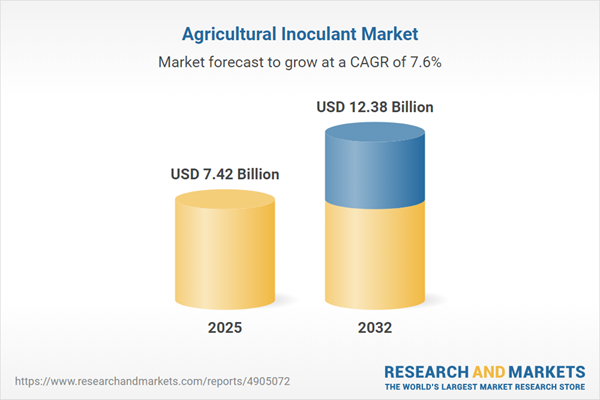Speak directly to the analyst to clarify any post sales queries you may have.
The agricultural inoculant market is evolving rapidly as industry leaders prioritize sustainability, regulatory adaptation, and digital integration to strengthen operations and supply chain transparency. Organizations are adapting strategies to ensure long-term growth through resilient, future-ready business models.
Agricultural Inoculant Market Snapshot
The global agricultural inoculant market is valued at USD 6.88 billion in 2024, with a projected CAGR of 7.61%, anticipated to reach USD 7.42 billion by 2025 and USD 12.38 billion by 2032. This growth is powered by accelerating demand for robust crop performance, renewed focus on soil vitality, and heightened adoption of sustainable agricultural practices. Enterprises are leveraging research and development initiatives to address evolving compliance expectations, and expanding technologically advanced product lines to generate business resilience. Extended investments in innovation are also supporting a competitive edge as organizations navigate shifting operational landscapes and regulatory variables in the sector.
Agricultural Inoculant Market Scope & Segmentation
This analysis delivers actionable segmentation and focused intelligence vital for senior decision-makers responsible for strategy within the agricultural inoculant sector. Understanding the following segments enables targeted planning and risk mitigation aligned with dynamic market requirements:
- Type: Microbial solutions including Azospirillum, Azotobacter, Frankia, Mycorrhizae, Rhizobium, and Trichoderma drive sustainable practices, aligning with compliance demands and elevating soil productivity goals.
- Crop Application: Inoculant formulations support cereals, grains, pulses, oilseeds, fruits, vegetables, turf, and ornamentals, allowing adaptation to specific environmental and agronomic needs for yield optimization.
- Formulation: Available in granule, liquid, and powder variants to maximize compatibility with precision agriculture as well as conventional approaches, providing deployment flexibility across diverse operational scenarios.
- End Use: Serving both conventional and organic sectors, products address mandates for sustainable, certifiable agricultural practices amid increasing demands for eco-conscious solutions.
- Application Method: Foliar sprays, seed treatments, and soil amendments optimize nutrient uptake and influence both crop and soil health, supporting targeted agronomic strategies.
- Sales Channel: Direct, intermediary, and digital platforms extend market reach in both established and emerging regions, tailoring procurement strategies to local conditions and buyer preferences.
- Regional Coverage: Analysis spans the Americas, Europe, Middle East & Africa, and Asia-Pacific, reflecting differences in regulation, supply logistics, and market preferences across geographies.
- Key Companies: Advancements from Novozymes A/S, BASF SE, Bayer AG, Chr. Hansen Holding A/S, Evonik Industries AG, Lesaffre S.A., Koppert Biological Systems B.V., Lallemand Inc., Rizobacter Argentina S.A., and Symborg S.L. establish sector benchmarks via innovation, stringent compliance, and enhanced traceability systems.
Clear segmentation enables the seamless integration of digital traceability tools, supporting transparent reporting and streamlined compliance across intricate agricultural supply chains.
Agricultural Inoculant Market: Key Takeaways
- Advanced product development supports the transition toward resilient operations and sustainable crop management, aligning with evolving agronomic needs.
- Collaborative partnerships between biotechnology leaders and agri-tech specialists encourage faster implementation and validation of biological inoculant solutions.
- Supply chain technology investments build operational safeguards and reduce exposure to evolving regulatory risks and shifts in market conditions.
- Direct procurement and digital-first strategies respond to changing buyer expectations, securing continuous product access in both mature and growth markets.
- Integrated compliance measures foster stronger industry trust and facilitate proactive engagement with regulators and agricultural stakeholders.
- Joint research and pilot initiatives underpin fast, data-driven validation cycles, aiding timely innovation and strategic alignment within organizations.
Agricultural Inoculant Market: Tariff Impact
Recent tariffs imposed by the US on selected raw materials and microbial strains have prompted manufacturers to reevaluate procurement models and increase collaboration with domestic suppliers. These adjustments reduce exposure to international price volatility and diminish regulatory unpredictability. Enterprises with flexible sourcing and responsive product development maintain operational continuity and adaptability against evolving trade circumstances.
Methodology & Data Sources
This report draws on robust quantitative forecasts, industry-vetted literature, regulatory guidelines, expert commentary, and comprehensive patent and white paper analysis. The methodology is designed to ensure data is accurate and highly relevant for leadership-level decision-making in the agricultural inoculant market.
Why This Agricultural Inoculant Market Report Matters
- Supports executive planning by highlighting shifts in regulatory demands, environmental targets, and operational pressures, empowering strategic clarity.
- Offers robust insight for organizational risk assessment and informed adaptation to align with evolving benchmarks in the sector.
- Equips decision-makers with the intelligence required to optimize commercial performance and proactively respond to new challenges in a changing market landscape.
Conclusion
This analysis empowers industry leaders to anticipate agricultural market transformation, build strategic partnerships, and refine competitive approaches within a framework driven by sustainability and compliance.
Additional Product Information:
- Purchase of this report includes 1 year online access with quarterly updates.
- This report can be updated on request. Please contact our Customer Experience team using the Ask a Question widget on our website.
Table of Contents
3. Executive Summary
4. Market Overview
7. Cumulative Impact of Artificial Intelligence 2025
Companies Mentioned
The companies profiled in this Agricultural Inoculant market report include:- Novozymes A/S
- BASF SE
- Bayer AG
- Chr. Hansen Holding A/S
- Evonik Industries AG
- Lesaffre S.A.
- Koppert Biological Systems B.V.
- Lallemand Inc.
- Rizobacter Argentina S.A.
- Symborg S.L.
Table Information
| Report Attribute | Details |
|---|---|
| No. of Pages | 187 |
| Published | October 2025 |
| Forecast Period | 2025 - 2032 |
| Estimated Market Value ( USD | $ 7.42 Billion |
| Forecasted Market Value ( USD | $ 12.38 Billion |
| Compound Annual Growth Rate | 7.6% |
| Regions Covered | Global |
| No. of Companies Mentioned | 11 |









